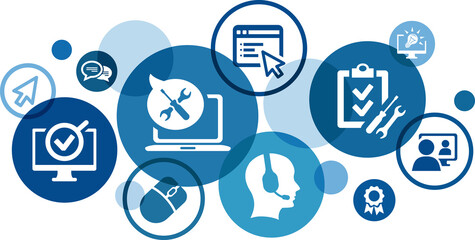Strategies to increase customer satisfaction
Customer satisfaction is more than just a goal, it’s the foundation of a business’s success. Customers are not only looking for a product or service; they’re seeking a connection that makes them feel valued and heard. Meeting their expectations is crucial to maintaining a strong, loyal customer base.
Achieving high customer satisfaction goes beyond offering a quality product; it’s about delivering an experience that leaves a lasting impression. With an overwhelming number of choices at their fingertips, customers now expect businesses to go way beyond than ever. By focusing on their needs and preferences, companies can ensure they remain top-of-mind and keep customers coming back.
In this article, we’ll share strategies you can implement to not only satisfy your customers but also foster long-term relationships that drive success and growth for your business.
What is customer satisfaction?
Customer satisfaction refers to the measure of how well a company’s products, services, or overall experience meet or exceed customer expectations. It’s not just about solving customers' problems, it’s about making them feel valued and appreciated every step of the way. When customers are satisfied, they’re more likely to return, recommend you to others, and even share their experiences to help you improve.
How to measure customer satisfaction?
To improve customer satisfaction, it’s essential to measure it accurately. There are various ways to assess how well your business is performing, ranging from simple surveys to more in-depth analyses. The key is to capture honest feedback that reflects the experiences of your customers.
This is where customer satisfaction models come in. These models provide structured frameworks that help businesses understand how well they are meeting customer expectations. By applying these models, you can gain a clear picture of your current satisfaction levels, which is the first step in identifying areas for improvement.
Types of customer satisfaction models
Here are some of the most widely used customer satisfaction models:
- The Disconfirmation of Expectation Model: This model is based on the premise that customer satisfaction is a result of the difference between customers’ expectations and the actual performance of the product or service. If a product or service exceeds expectations, customers are highly satisfied. If it falls short, dissatisfaction occurs. This model is widely used in assessing customer feedback after a transaction or experience.
- The Performance Model: The Performance Model focuses on evaluating specific attributes of a product or service and measuring how well they perform compared to customer expectations. This model helps businesses pinpoint strengths and weaknesses in specific areas of their offerings, such as quality, value, or speed of service.
- The Rational Expectations Model: This model assumes that customers make purchasing decisions based on a rational evaluation of available information, and their satisfaction is based on how well a product or service meets those expectations. It emphasizes the importance of clear communication about what customers can expect before they make a decision.
- The Expectations Artefact Model: In this model, customer satisfaction is shaped by the expectations created by external factors such as advertising, word of mouth, and prior experiences. It highlights the role of external influences on shaping a customer’s perception of a brand or product, which can directly affect their satisfaction level.
- The Kano Model: The Kano Model focuses on understanding customer needs and classifying them into categories based on how they influence satisfaction. The model divides customer needs into five categories:
- Basic needs: These are the essential elements customers expect. If these needs are not met, customers will be dissatisfied.
- Performance needs: These are the features or attributes that customers expect to be fulfilled in a performance-oriented way. The better you perform in this area, the higher the satisfaction.
- Excitement needs: These are unexpected delights that, when present, can significantly enhance customer satisfaction, even though they were not explicitly expected.
- Indifferent needs: These are features that don’t significantly affect satisfaction regardless of their presence or absence.
- Customer Satisfaction Index Models (ACSI / ECSI): These are statistical models used to quantify satisfaction at a national or industry level, such as the American American Customer Satisfaction Index (ACSI) and European Customer Satisfaction Index (ECSI). They typically include: Customer expectations, perceived quality, perceived value, customer complaints, and customer loyalty.
- The SERVQUAL Model: that measures the gap between customer expectations and perceptions across five dimensions: tangibles, reliability, responsiveness, assurance, and empathy.
These are just some of the most widely recognized frameworks for understanding and measuring customer satisfaction. However, there are many tools, metrics, and KPIs used to perform this analysis, such as the Net Promoter Score (NPS), the Customer Satisfaction Score (CSAT), and the Customer Effort Score (CES), providing direct, quantifiable feedback on the customer experience, enabling continuous improvement based on real data.
How to improve customer satisfaction?
Understanding what drives satisfaction is only the beginning, but putting that insight into action is where real change happens. When it comes to developing a solid CS strategy to increase customer satisfaction, it’s essential to create an action plan based on different stages:
- Customer feedback collection: Gather insights through surveys, reviews, support interactions, and social media. The goal is to capture the voice of the customer in real time and across different touchpoints.
- Analysis: Review the feedback provided by your customers to develop a targeted and effective action plan.
- Action implementation: Translate insights into tangible changes. This could mean improving processes, training staff, refining your product, or enhancing communication.
- Closing the loop: Communicate back to your customers. Let them know their feedback has led to improvements. This builds trust and shows that their voices matter.
- Continuous monitoring: Track satisfaction using different KPIs, and monitor trends over time to evaluate the impact of your changes and adapt as customer needs evolve.
While this is a structured approach, there are many different ways to improve customer satisfaction depending on business model, industry, and customer expectations.
6 ways to improve customer satisfaction
Below are several actionable strategies to significantly and quickly boost customer satisfaction:
Accessible support, anytime
Ensure your customers can reach you when it matters most. Adopt a multi-channel approach—combining live chat, email, phone, and self-service tools—to offer continuous, convenient assistance. Incorporate AI-powered customer services solutions like chatbots to resolve simple, repetitive queries instantly. This not only provides 24/7 availability but also reduces the workload on your support team, allowing them to focus on more complex and high-value interactions.
Reduce customer effort
The easier it is for a customer to achieve their goal, the more satisfied they’ll be. Whether it’s finding information, making a purchase, or resolving an issue, simplicity is key. Aim to minimize friction at every stage of the journey.
The use of tools like the Customer Effort Score (CES) is really important to identify and remove unnecessary steps in key processes. Also, remember to constantly and proactively request feedback across all touchpoints.
Train and empower your team
Whether you're outsourcing your customer service or handling it internally, your people are your most valuable asset when it comes to customer satisfaction. Invest in training not just for technical skills, but also for empathy, problem-solving, and ownership. Empower your frontline employees to make decisions that serve the customer without needing layers of approval.
Turn complaints into opportunities
Negative reviews and complaints aren’t just problems, they’re valuable insights. When handled correctly, they can help you identify friction points, improve your service, and even strengthen relationships with your customers.
Start by actively monitoring and analyzing complaints across all channels. When a customer leaves a negative review, reach out directly to understand their issue and offer a solution. Keep them informed about the progress and make sure to follow up once the issue is resolved.
If you choose to respond publicly on review platforms, do so with care, especially if emotions are running high. A calm, constructive response shows transparency and professionalism.
Personalize the customer experience
Customers don’t want to feel like just another number. Tailor your communication, product recommendations, and support based on customer history, preferences, or behavior. Even small touches, like using their name or remembering past interactions, can make a big difference in perceived value and care.
Be proactive and consistent:
Don’t wait for problems to escalate. Track reviews regularly, follow up on recurring issues, and establish internal guidelines for how and when to respond. Consistency builds trust and shows your brand genuinely cares.
Conclusion
Improving customer satisfaction is an ongoing commitment that requires structure, empathy, and action. From understanding what satisfaction truly means to implementing proven models and strategies, businesses that prioritize the customer experience position themselves for long-term success. Whether it’s through more accessible support, empowered teams, or proactive handling of feedback, every step you take to meet and exceed expectations contributes to stronger relationships and greater loyalty.
Ultimately, customer satisfaction is a reflection of how well you listen, adapt, and deliver. By staying responsive to feedback, acting with consistency, and keeping the customer at the heart of every decision, you’ll not only improve satisfaction, you’ll set your brand apart in a crowded marketplace.






